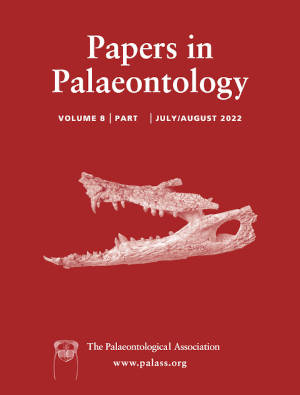Article: Sclerite assembly, articulation and protective system of Lower Devonian machaeridians
Publication: Papers in Palaeontology
Volume:
8
Part:
1
Publication Date:
2022
Article number:
e1410
Author(s):
Sarah M. Jacquet, Tara Selly, James D. Schiffbauer, and Glenn A. Brock
DOI:
10.1002/spp2.1410
Abstract
Abstract Machaeridians are a unique group of Palaeozoic annelids that secreted a calcitic armour consisting of dorsally interlocking sclerites running along the entire length of the animal. Preserved remains are most commonly found as disarticulated sclerites, although rare articulated specimens have also been preserved as moulds, recrystallized calcite and even pyrite replacement. These preservational modes unfortunately have obscured direct observation of the dorsal interlocking hinge, thus impeding our understanding of the functional protection offered by this biological armour. Herein, we document and describe articulated silicified lepidocoleids (Lepidocoleus caliburnus sp. nov., Lepidocoleus shurikenus sp. nov. and Lepidocoleus sp.) in association with isolated sclerites of Lepidocoleus cf. kuangguoduni from the Lower Devonian (Pragian) Garra Formation of New South Wales, Australia. Articulated specimens include straight and enrolled scleritome configurations possessing opposing and alternate dorsal hinge articulation, respectively. Silicified scleritomes were analysed using x-ray microtomography to investigate the three-dimensional morphology, cross-sectional geometry and dorsal hinge articulation and configuration of individual sclerites in the armour assembly. Virtual dissection of articulated specimens alongside reconstructions of isolated sclerites reveal distinctions in sclerite morphology across opposing and alternate articulation mechanisms, including a novel system not previously observed in lepidocoleids. The combination of heterogeneous sclerite cross-sectional geometry with sclerite overlap also serves to maintain a uniform thickness of the armour assembly and presumably improve resistance to predatory attack.
